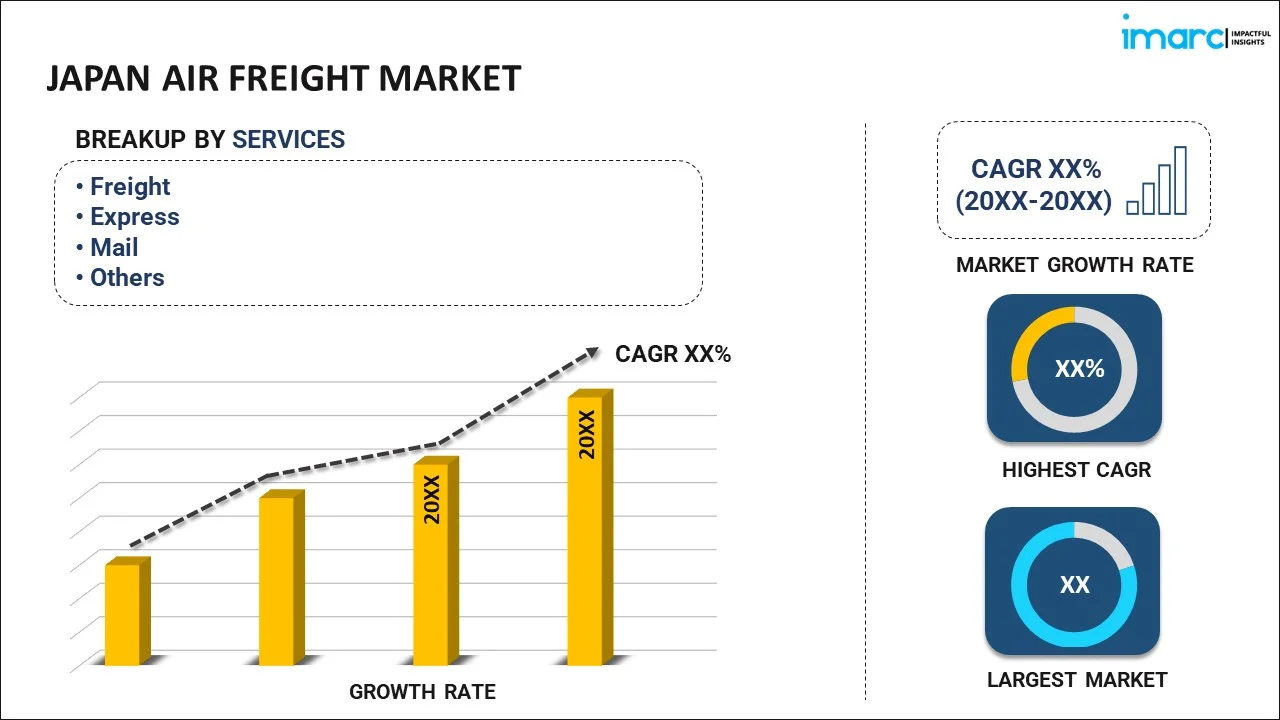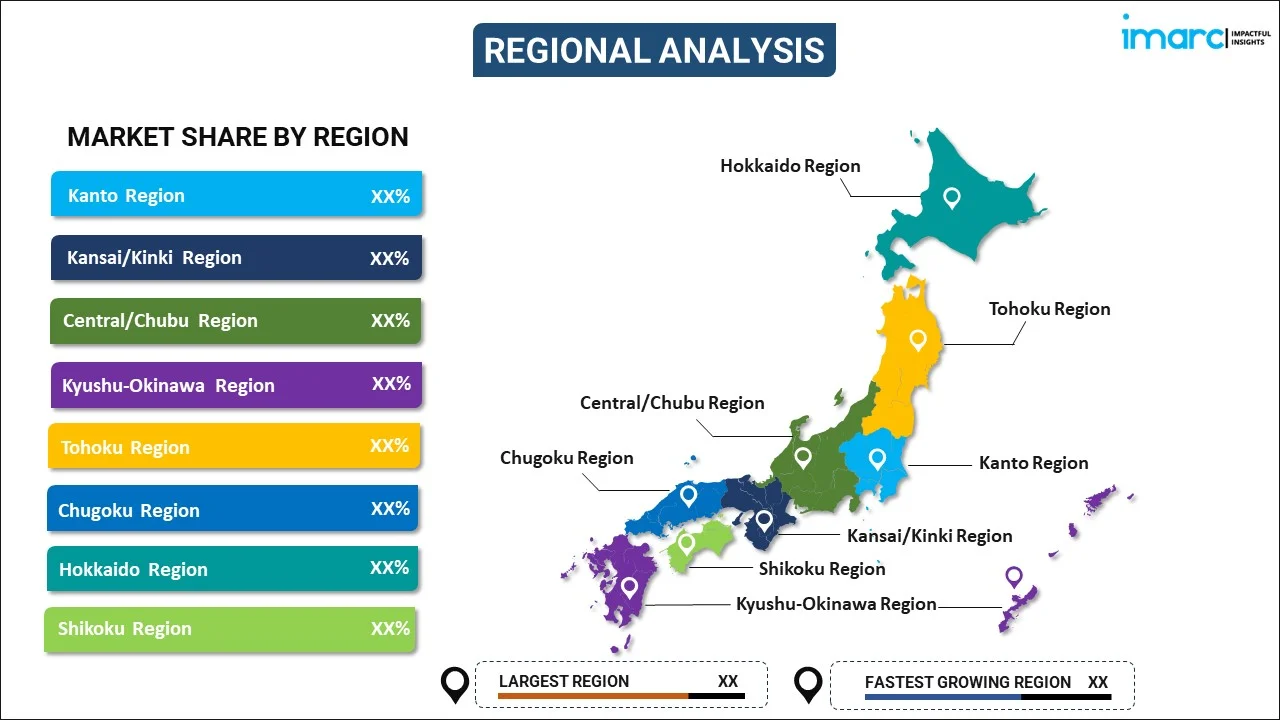
Japan Air Freight Market Report by Service (Freight, Express, Mail, and Others), Destination (Domestic, International), End User (Private, Commercial), and Region 2025-2033
Market Overview:
Japan air freight market size reached USD 18.9 Billion in 2024. Looking forward, IMARC Group expects the market to reach USD 29.3 Billion by 2033, exhibiting a growth rate (CAGR) of 4.85% during 2025-2033. The rapid growth of e-commerce that has led to increased demand for fast and efficient delivery of goods to meet the expectations of quick and reliable shipping for their customers, is driving the market.
|
Report Attribute
|
Key Statistics
|
|---|---|
|
Base Year
|
2024
|
|
Forecast Years
|
2025-2033
|
|
Historical Years
|
2019-2024
|
|
Market Size in 2024
|
USD 18.9 Billion |
|
Market Forecast in 2033
|
USD 29.3 Billion |
| Market Growth Rate 2025-2033 | 4.85% |
Air freight, also known as air cargo or air transportation, refers to the shipment of goods and commodities via aircraft. It is a crucial component of the logistics and supply chain industry, facilitating the rapid movement of goods across long distances. Air freight offers several advantages, including speed, reliability, and the ability to reach remote or distant destinations quickly. The process of air freight involves cargo being loaded onto aircraft, ranging from small cargo planes to large cargo jets, depending on the volume and weight of the goods being transported. Specialized packaging and handling are often required to ensure the safety and security of the cargo during transit. Air freight services are utilized for a wide range of products, from perishable goods like fresh produce and pharmaceuticals to high-value items like electronics and machinery. It is mostly preferred for time-sensitive shipments and products with high market demand.
Japan Air Freight Market Trends:
The air freight market in Japan is influenced by a myriad of drivers, intricately interwoven to shape its trajectory. Primarily, the burgeoning e-commerce sector serves as a catalyst, propelling demand as consumers increasingly favor expedited delivery options. Consequently, technological advancements play a crucial role; innovations in aircraft design and cargo handling systems enhance efficiency, ensuring quicker and more reliable service. Apart from this, the perishable goods industry necessitates rapid transportation, driving consistent demand for air freight services. Additionally, the agility air freight offers in the face of unpredictable events, such as natural disasters, also underscores its indispensability. Furthermore, government policies and regional trade agreements also exert significant influence, shaping the operational landscape and potentially fostering a conducive environment for market growth. However, it is imperative to acknowledge the environmental concerns associated with air freight, prompting the industry to innovate and adopt sustainable practices. Collectively, these drivers contribute to a dynamic and ever-evolving air freight market in Japan, underlining its critical role in the economy.
Japan Air Freight Market Segmentation:
IMARC Group provides an analysis of the key trends in each segment of the market, along with forecasts at the country level for 2025-2033. Our report has categorized the market based on service, destination, and end user.
Service Insights:

- Freight
- Express
- Others
The report has provided a detailed breakup and analysis of the market based on the service. This includes freight, express, mail, and others.
Destination Insights:
- Domestic
- International
A detailed breakup and analysis of the market based on the destination have also been provided in the report. This includes domestic and international.
End User Insights:
- Private
- Commercial
The report has provided a detailed breakup and analysis of the market based on the end user. This includes private and commercial.
Regional Insights:

- Kanto Region
- Kansai/Kinki Region
- Central/ Chubu Region
- Kyushu-Okinawa Region
- Tohoku Region
- Chugoku Region
- Hokkaido Region
- Shikoku Region
The report has also provided a comprehensive analysis of all the major regional markets, which include Kanto Region, Kansai/Kinki Region, Central/ Chubu Region, Kyushu-Okinawa Region, Tohoku Region, Chugoku Region, Hokkaido Region, and Shikoku Region.
Competitive Landscape:
The market research report has also provided a comprehensive analysis of the competitive landscape. Competitive analysis such as market structure, key player positioning, top winning strategies, competitive dashboard, and company evaluation quadrant has been covered in the report. Also, detailed profiles of all major companies have been provided.
Japan Air Freight Market Report Coverage:
| Report Features | Details |
|---|---|
| Base Year of the Analysis | 2024 |
| Historical Period | 2019-2024 |
| Forecast Period | 2025-2033 |
| Units | Billion USD |
| Scope of the Report | Exploration of Historical Trends and Market Outlook, Industry Catalysts and Challenges, Segment-Wise Historical and Future Market Assessment:
|
| Services Covered | Freight, Express, Mail, Others |
| Destinations Covered | Domestic, International |
| End Users Covered | Private, Commercial |
| Regions Covered | Kanto Region, Kansai/Kinki Region, Central/ Chubu Region, Kyushu-Okinawa Region, Tohoku Region, Chugoku Region, Hokkaido Region, Shikoku Region |
| Customization Scope | 10% Free Customization |
| Post-Sale Analyst Support | 10-12 Weeks |
| Delivery Format | PDF and Excel through Email (We can also provide the editable version of the report in PPT/Word format on special request) |
Key Questions Answered in This Report:
- How has the Japan air freight market performed so far and how will it perform in the coming years?
- What has been the impact of COVID-19 on the Japan air freight market?
- What is the breakup of the Japan air freight market on the basis of service?
- What is the breakup of the Japan air freight market on the basis of destination?
- What is the breakup of the Japan air freight market on the basis of end user?
- What are the various stages in the value chain of the Japan air freight market?
- What are the key driving factors and challenges in the Japan air freight?
- What is the structure of the Japan air freight market and who are the key players?
- What is the degree of competition in the Japan air freight market?
Key Benefits for Stakeholders:
- IMARC’s industry report offers a comprehensive quantitative analysis of various market segments, historical and current market trends, market forecasts, and dynamics of the Japan air freight market from 2019-2033.
- The research report provides the latest information on the market drivers, challenges, and opportunities in the Japan air freight market.
- Porter's five forces analysis assist stakeholders in assessing the impact of new entrants, competitive rivalry, supplier power, buyer power, and the threat of substitution. It helps stakeholders to analyze the level of competition within the Japan air freight industry and its attractiveness.
- Competitive landscape allows stakeholders to understand their competitive environment and provides an insight into the current positions of key players in the market.
Need more help?
- Speak to our experienced analysts for insights on the current market scenarios.
- Include additional segments and countries to customize the report as per your requirement.
- Gain an unparalleled competitive advantage in your domain by understanding how to utilize the report and positively impacting your operations and revenue.
- For further assistance, please connect with our analysts.
 Inquire Before Buying
Inquire Before Buying
 Speak to an Analyst
Speak to an Analyst
 Request Brochure
Request Brochure
 Request Customization
Request Customization




.webp)




.webp)












